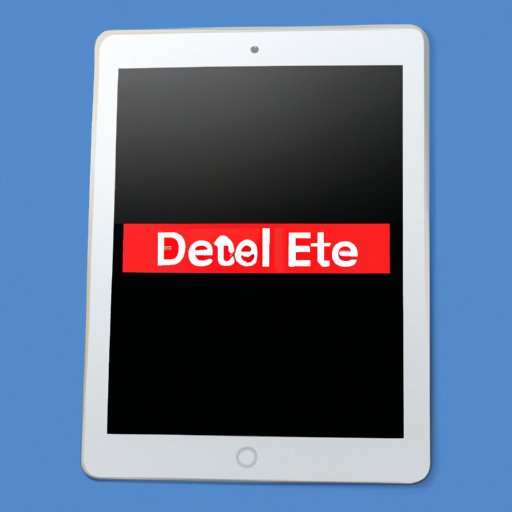I. Introduction
If you’re an avid iPad user, it’s likely that you’ve amassed a collection of apps over time. While the newest gadgets have increased storage and capabilities, it’s still essential to delete unused apps from time to time to avoid clutter. In this tutorial, we’ll provide you with a step-by-step guide on how to delete apps on an iPad, as well as some common errors and alternative app deletion methods.
II. Step-by-Step Guide
There are essentially two methods for deleting apps on an iPad: the Home Screen method and the Settings method. Here’s how you can utilize either method:
Home Screen Method
- Navigate to the Home Screen on your iPad using one finger to swipe up from the bottom or two fingers to pinch outwards to zoom out from your current app display.
- Locate the app you want to delete and press down on it until all apps shake.
- Once all apps are shaking, you’ll see a small “X” on the top left corner of the app icon. Click on the “X” to delete the app.
- You’ll then receive a pop-up notification asking you to confirm your deletion. Click “Delete.”
Settings Method
- Navigate to the “Settings” app on your iPad.
- Click on “General.”
- Select “iPad Storage.”
- Locate the app you want to delete and click on it.
- Click “Delete App “
- You’ll then receive a pop-up notification asking you to confirm your deletion. Click “Delete.”
If you’re struggling with either method, don’t worry – we’ll explore common issues and troubleshooting solutions later on.
III. Video Tutorial
While many users learn best through written guides, others prefer visual aids. If you’re a visual learner, a video tutorial may be a helpful alternative. Check out this video tutorial for additional aid in app deletion.
IV. Common Errors and Troubleshooting
If you’ve tried to delete apps and have faced errors, you’re not alone. Here are some common issues and solutions:
The App Icon is Greyed Out
If you see that the app icon is greyed out, this means that the app is in use or cannot be deleted. Ensure that you’re not using the app and try again.
No “X” is Displayed on App Icons
If no “X” is displayed on the app icons, this means that the feature is disabled. To fix this, navigate to “Settings,” then “Screen Time,” then “Content & Privacy Restrictions,” then “iTunes & App Store Purchases,” and ensure that “Deleting Apps” is enabled.
The Delete Button is Not Responsive
If you’re clicking on the “Delete” button and nothing is happening, give your device a restart. This should clear any temporary issues interfering with the app deletion process.
V. Exploring Alternative App Deletion Methods
While the Home Screen and Settings methods can effectively delete apps, there are alternative methods to consider:
Third-Party Apps
Some users turn to third-party apps like CleanMyMacX and iMazing to organize their app collections. These apps can be beneficial if you’re dealing with a large collection or prefer management outside of the iPad device.
iCloud
If you use iCloud to backup your iPad, you can also delete apps from there. Simply navigate to “Settings,” select your name at the top of the screen, choose “iCloud,” and click “Manage Storage.” From there, you can select “Backups” and “Delete App Data.”
It’s essential to explore the pros and cons of each alternative app-deletion method to determine which option is best suited for you.
VI. The Importance of Deleting Unused Apps
With the luxury of ample storage on newer models, it’s easy to forget the importance of deleting unused apps. Besides taking up unnecessary space, unused apps can also affect your device’s battery life, efficiency, and performance.
To identify apps you don’t use, navigate to “Settings,” then “General,” then “iPad Storage,” and view the apps taking up most storage. From there, determine which apps you don’t use and delete them via the previously mentioned methods.
VII. Comparing App Deletion on iPad and Android
If you’ve used both an iPad and Android device, you may have noticed differences in the app deletion process between the two platforms. Here are some key differences and pros and cons for each:
iPad
Pros: Easy to locate and delete apps, visual indicators for unused apps, straightforward Settings method.
Cons: Unable to delete essential built-in apps, no way to bulk-delete apps on one screen.
Android
Pros: Ability to disable or “hide” built-in apps, straightforward Settings method, ability to bulk-delete apps.
Cons: No visual indicators for unused apps, app placements may vary between devices, may require third-party management apps for efficient organization.
VIII. Conclusion
We hope this tutorial has provided a comprehensive step-by-step guide to deleting apps on an iPad. Remember to explore alternative app deletion methods, keep an eye out for visually identified unused apps, and delete apps you don’t use to enjoy an organized and efficient device.
